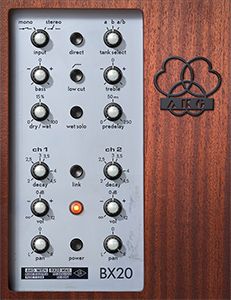With so many choices to pick from, selecting a reverb from the library of options in the UAD plugin ecosystem can be a bit of an intimidating task! I’d like to break down some of my favorites for you, and steer you towards some of the key features of the various UAD ambiance processors.
DreamVerb
Often overlooked, DreamVerb doesn’t model a specific piece of vintage gear. Perhaps that’s why it’s not necessarily the first choice for many Apollo users. You shouldn’t count DreamVerb out, though. Its room modeling is strong, you can adjust the parameters in real time without any artifacts, and it only uses 11 percent DSP—very efficient! I use it for hall modeling all the time.

AMS RMX16
The AMS RMX16 is definitely a boutique choice. It uses quite a lot of DSP, so I find myself utilizing it as a drum bus or vocal bus and maximizing what I’m getting for my 40% DSP. It’s pretty lush, though, and it can be very tempting to use anytime I’m going for a stadium sound.
AKG BX20
This plugin can be downright spooky and ethereal in its nature. It’s a spring reverb modeler, and while you can find a seemingly unlimited amount of use for it, I find myself reaching for the AKG BX20 whenever I want a darker or more abstract tone. The BX20 works great on a drum bus, and wonderfully on guitars.

Lexicon 224
The Lexicon 224 is slim and fit, costing you only around 11% DSP. With buttons to adjust your wet/dry mix rather than a knob, you can get a bit more precise with programming in exactly the amount of ambiance you want. There’s special attention paid to the decay stage of the reverb with this guy, so whenever I want a reverb that’s noticeable in the mix, I’ll often reach for the Lexicon so I can craft the tail end of it as I see fit.
Ocean Way Studios
The Ocean Way plugin allows you to do both room modeling (albeit a very specific room!) as well as reverb. Don’t expect cathedral like sounds here, you’re modeling a legendary live room. If you want to sweeten your home studio, however, and make a drum set sound like it was recorded in a ‘downtown sound’ type environment, you can definitely punch up your mix with Ocean Way. It’s powerful, and uses about 38% DSP, but it’s a very specific tool.

EMT 140 and 250
The EMT plugins are my two ‘first stop’ reverbs when I reach for the ambiance dial. The 140 and the 250 are quite different in workflow, but the difference in sound can be subtle. The 140 is a beautiful plate reverb that is absolutely perfect for vocals and acoustic instruments. The 250 really shines on guitar and drums, but I also use it on vocals all the time. They are both wonderfully efficient plugins, with the 250 clocking in at only 6% DSP. That means you can use just about as many instances of them as you could ever want without batting an eye.
Hello? Echo….
I truly enjoy using all of the UAD reverbs. I don’t like to pin myself down to one—part of the fun and love that I have of producing music involves choosing different palettes to sculpt my sound with, and I wouldn’t have it any other way!





 © 2024 Ask.Audio
A NonLinear Educating Company
© 2024 Ask.Audio
A NonLinear Educating Company
Discussion
Want to join the discussion?
Create an account or login to get started!